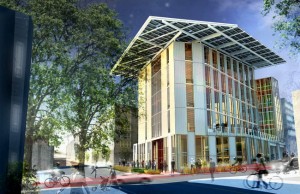By Erica Rascón on January 31, 2013 in News

The Bullitt Building joins ranks with other elite Living Building Challenge certified structures, becoming the Greenest Commercial Building in the World.
The green building community continues to grow by leaps and bounds, with fivefold expected growth leading into 2016. As sustainable features become more common place, the bar of excellence rises, prompting greater ingenuity from design and build firms. With rising standards come increased benefits to earth and its inhabitants.
Living Building Challenge (LBC) poses some of the most rigorous standards in the green building industry, approving certification only after the building in question has functioned optimally for one year. Living building architecture encapsulates net zero water, energy, and waste standards within a shell that makes the most of its surrounding geological characteristics. Relying heavily on its immediate environment, a living building acts as an efficient live organism: it thrives on a sustainable life cycle that allows it to draw sustenance from local conditions, produce energy for its own operations, and release minimal waste that is then recycled.
LBC encourages design and build firms to create such ultra-high performance buildings that are also a source of inspiration for those who dwell in its interiors, as well as those who are simply passing by. A living building aims to be as aesthetically pleasing as it is functional.
The workings of a living building
Ultimately, the ideal building sees “comfort, convenience, productivity, acoustics, views from inside-out and healthy indoor air” as primary concerns. The Bullitt Foundation has achieved just that.
- The location selected for The Bullitt Building proves to be accessible by public transit, bike routes, and pedestrian traffic. The Seattle neighborhood enjoys a Walk Score of 98/100.
- The six-story structure is fully solar powered by a series of arrays that cover its massive roof.
- The roof also catches rainwater, channeling it to a cistern and purification system to be used throughout the year.
- Green roofing helps to regulate internal temperatures throughout the year.
- Each inhabitable room has access to natural sun light and fresh air through motorized windows. The windows also serve to facilitate climate control inside of the building.
- FSC certified wood adorns the interior of the building.
- No “Red List” building materials were used during construction.
- The building meets the strict criteria of net zero energy, water and waste.
- The smallest details were not overlooked. Glass stairwells with stunning exterior views gently lure occupants away from the elevators, promoting one tiny nudge towards fitness.
The structure alone cannot uphold all sustainability standards. Tenants also have a role to play. Each tenant is given an energy budget, which requires consideration of the machines and devices used within the building. Tenants are also encouraged to participate in green living practices that keep the community in sync with the building.
Learn more about the process needed to create the Greenest Commercial Building in the World.
League of extraordinary structures
Unlike the U.S. Green Building Council’s LEED programs, very few builders have risen to the challenges put forth by the International Living Building Institute. Only four North American structures grace the organization’s website to date:
Tyson Living Learning Center of Washington University in Eureka, Missouri is “a living landscape for environmental research and education,” that is comprised of a 2,000 acre outdoor laboratory and research facilities for students studying the environment and sustainability.
The Omega Center for Sustainable Living in Rhinebeck, New York houses a natural water reclamation facility and learning center that offer educational opportunities for community members interested in sustainable living.
Eco-Sense in Victoria, British Columbia is “North America’s first code-approved seismically engineered load bearing insulated cob house.” Tours and workshops held at the home encourage interested parties to participate in green building and living a “reasonable life.”
Getting started
To learn more about International Living Building Institute’s Living Building Challenge or to register a project, visit their new website at Living-Future.org.
Interested parties are also welcome to participate in seminars, events, and workshops such as the Resilience & Regeneration, taking place at the Seattle Westin on May 15 – 17, 2013.


